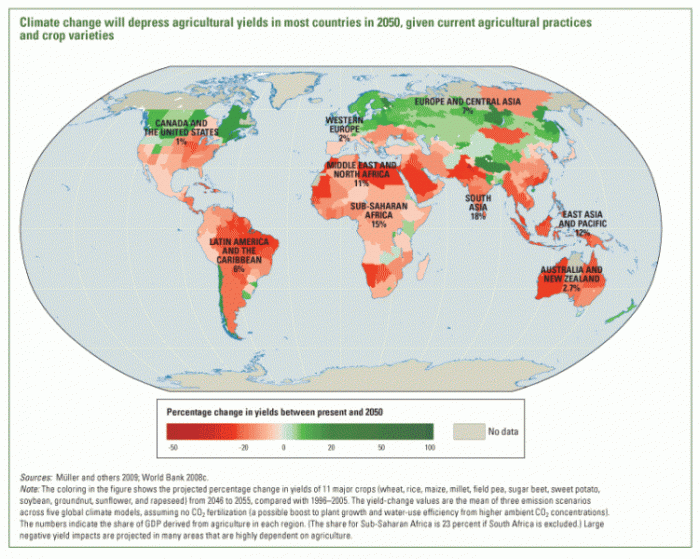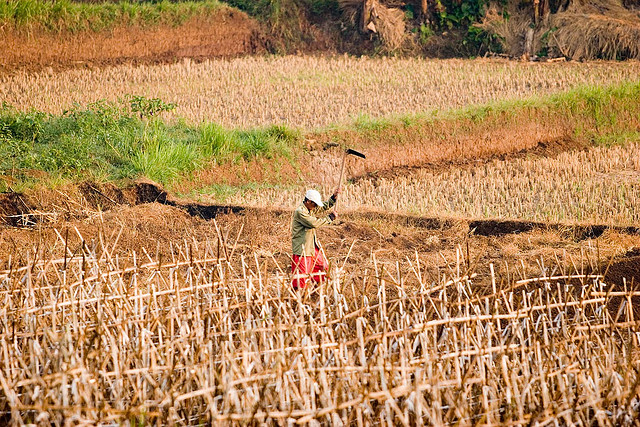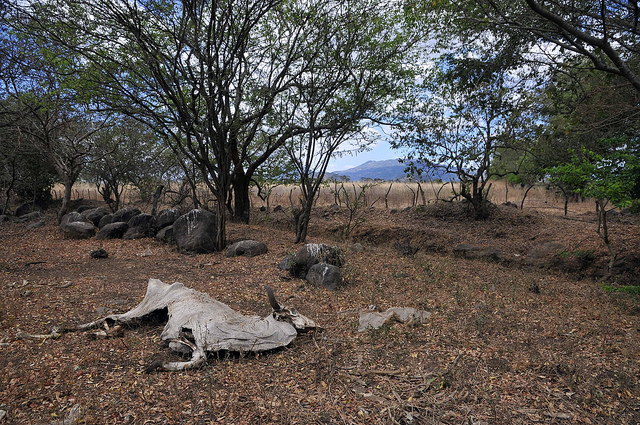Temperature and Heat Waves
Model forecasts under SRES A1B and A2 are for 2-4oC warming by 2100 with the most significant increase in high-latitude regions. In addition, the forecasts indicate a much higher likelihood of heat waves in the future. As it turns out, an increase in average temperature can have a positive impact on agriculture, lengthening the growing season in regions with cool spring and fall seasons. Regional and global simulations allow predictions of temperature increase on crop yield. The results (see figure below) show that modest temperature increases produce increased yields for some crops. Warming will also lead to a decrease in the occurrence of severe winter cold stress on crops, causing a pole-ward shift in the feasibility of regions for agricultural activities. This is especially important for high-yield tropical crops such as rice. Warming will have a greater impact in the Northern Hemisphere, where there is more cultivated area in high latitude areas.

However, warming ultimately reaches a limit where yield curves start to decrease for all crops. Globally, this threshold is reached at temperature increases over about 3oC. Crop yields also decline precipitously at temperatures above 30oC; although plants develop faster in warm temperatures, photosynthesis has a temperature optimum in the range of 20° to 25°C, and, above this range, plants have less time to accumulate carbohydrates, fats, and proteins. Because individual plants cannot move, they have developed mechanisms that allow them to tolerate higher temperatures and adapt to changing soil conditions. These mechanisms include the production of proteins that lessen heat-shock, as well as the ability to conduct photosynthesis during periods of heat. Such adaptations will partially determine where a crop can survive the impact of climate change.

Warming will have negative impacts on crop yield in regions where summer heat limits production, and it will lead to more frequent extreme high heat stress on crops. Heat stress varies by plant but includes lack of emergence of new plant material or damage to it, water deficit as a result of high evaporation, damage to reproductive development, and death. In addition, climate change will lead to increased soil evaporation rates, which stress crops and also increase the intensity of droughts.
Heat waves are usually known for their human toll. For example, the Great Chicago heat wave of 1995 led to over 700 deaths as a result of five extremely warm and humid days with a heat index reaching 125 degrees. A prolonged heat wave in Northern Europe in 2003 killed more than 40,000 people and led to a 20 to 36% decrease in the yields of grains and fruits. Heat waves are defined differently in different places, but usually, are defined as a specific number of days over a certain temperature. Prolonged heat waves can also cause significant damage to crops and livestock, with major economic losses. In Russia, an extended heat wave in 2010 caused 50,000 deaths and a loss of 25% of the grain yield at a cost of $15 billion. In the central US, more than 6000 cattle died in the July 2011 heat wave. And the heat wave of 2012 in the same region resulted in the worst corn crop in two decades.

